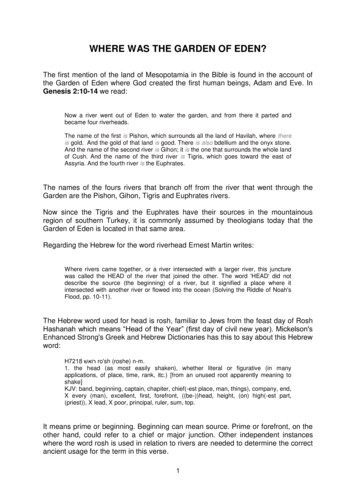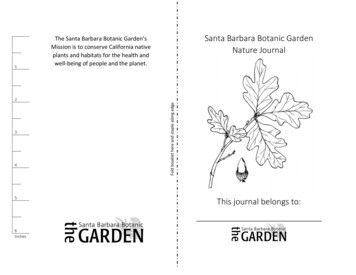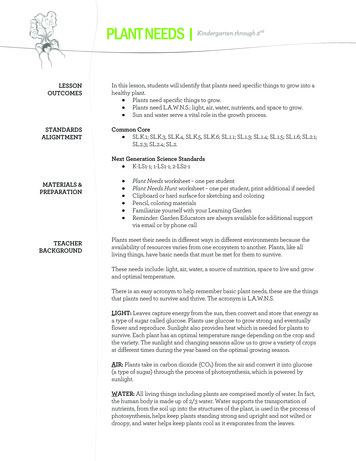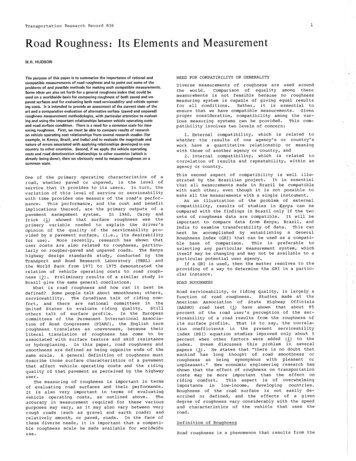
Transcription
WHERE WAS THE GARDEN OF EDEN?The first mention of the land of Mesopotamia in the Bible is found in the account ofthe Garden of Eden where God created the first human beings, Adam and Eve. InGenesis 2:10-14 we read:Now a river went out of Eden to water the garden, and from there it parted andbecame four riverheads.The name of the first is Pishon, which surrounds all the land of Havilah, where thereis gold. And the gold of that land is good. There is also bdellium and the onyx stone.And the name of the second river is Gihon; it is the one that surrounds the whole landof Cush. And the name of the third river is Tigris, which goes toward the east ofAssyria. And the fourth river is the Euphrates.The names of the fours rivers that branch off from the river that went through theGarden are the Pishon, Gihon, Tigris and Euphrates rivers.Now since the Tigris and the Euphrates have their sources in the mountainousregion of southern Turkey, it is commonly assumed by theologians today that theGarden of Eden is located in that same area.Regarding the Hebrew for the word riverhead Ernest Martin writes:Where rivers came together, or a river intersected with a larger river, this juncturewas called the HEAD of the river that joined the other. The word 'HEAD' did notdescribe the source (the beginning) of a river, but it signified a place where itintersected with another river or flowed into the ocean (Solving the Riddle of Noah'sFlood, pp. 10-11).The Hebrew word used for head is rosh, familiar to Jews from the feast day of RoshHashanah which means ―Head of the Year‖ (first day of civil new year). Mickelson'sEnhanced Strong's Greek and Hebrew Dictionaries has this to say about this Hebrewword:H7 8ro'sh (roshe) n-m.1. the head (as most easily shaken), whether literal or figurative (in manyapplications, of place, time, rank, itc.) [from an unused root apparently meaning toshake]KJV: band, beginning, captain, chapiter, chief(-est place, man, things), company, end,X every (man), excellent, first, forefront, ((be-))head, height, (on) high(-est part,(priest)), X lead, X poor, principal, ruler, sum, top.It means prime or beginning. Beginning can mean source. Prime or forefront, on theother hand, could refer to a chief or major junction. Other independent instanceswhere the word rosh is used in relation to rivers are needed to determine the correctancient usage for the term in this verse.1
David Rohl in his book "Legend - The Genesis of Civilisation", like most theologians,suggests that the Garden of Eden was in eastern Turkey near the source of theTigris and Euphrates. I quote now from his abovementioned book which the researchthat he has provided which supports that conclusion of his:Down the Garden PathThe location of the Garden of Eden has intrigued the inquisitive and the religious eversince the Bible was first read. Today, few scholars would be brave or recklessenough to suggest that the land of Eden actually once existed - let alone that it wasfrom this place that civilised humankind first emerged. This approach speaks volumesfor the attitudes of modem scholarship where caution and outright scepticism nowseem to prevail.In the century which preceded the Second World War, however, things were ratherdifferent. Scholars of the Victorian and Edwardian eras seem to have been rathermore adventurous (some might say naive) in their thinking and, because of this, acomprehensive synthesis between the biblical text and archaeology was still alaudable aim. Intui tion and reasoned speculation were acceptable tools of theancient historian - so long as ideas were predominantly based on the availableevidence. And much of that evidence came from the Bible which was still a principalsource book for ancient history.Over that hundred-year period many Bible researchers attempted to pinpoint Eden'swhereabouts on the basis of the description provided in the book of Genesis. There itstates that four rivers flowed out from Eden. In Chapter Two of Genesis these riversare named as:(1) the Gihon - winding through the land of Cush;(2) the Pishon - winding through the land of Havilah;(3) the Hiddekel Tigris - flowing east of Ashur;(4) the Perath Euphrates - known to everyone.The geographical clues have always been there but, in spite of this, the variousinterpretations of this key passage have differed considerably.Some scholars looked to their counterparts from the Roman world - the historians andearly church fathers such as JOSEPHUS, St. AUGUSTINE and St. JEROME. Even intheir time the question of the whereabouts of Eden was a subject for speculation anddebate. The Jewish historian, Josephus, identified the land of Cush', bordering onEden with the well-known African kingdom of Kush, south of Egypt. As a result, thefirst of the four rivers which flowed from Eden - the Gihon (from a root meaning toburst forth') - was identified as the river Nile.This seemed to be supported by the fact that both the Ethiopians and the EgyptianCOPTS referred to their river as the ‗Geion'. However, the renowned nineteenthcentury biblical scholar, Friedrich GESENIUS, observed that this name may haveitself derived directly from the Alexandrine exposition of the Genesis text.In other words the river was named after the Gihon precisely because of theassociation of African Kush with biblical Cush. The Christian communities of Africahad done exactly what the early church fathers were now doing in identifying the Nilewith the Gihon.2
The Hiddekel (Arab. Diglat) and Perath (Arab. Firat) were the two well-known rivers ofMesopotamia which the classical authors knew as the Tigris and Euphrates.Thus a broad view of the primeval earthly paradise was established with the land ofEden covering a vast expanse stretching from ancient Sumer in the north to the Nilevalley in the south. It then became a straightforward assumption to identify thesecond river of Eden - the Pishon (from a root meaning ‗to spread') - with one of theother great rivers of the region - the Indus or the Ganges - which flow throughPakistan and India respectively.Whereas Josephus, Augustine and Jerome conjectured that the Ganges was thebiblical Pishon, Gesenius opted for the Indus valley as the location of the biblical landof Havilah. His view was soon supported by the discovery of a high civilisation in thisregion which dated back to early biblical times.The heart of Eden was therefore identified as the central Levant and, in particular, thePromised Land itself. This was all very convenient with the cross-roads of three faiths- Jerusalem - recognised within the theology of Judaism (and therefore Christianity)as the gateway into paradise on the final Day ofJudgement Some scholars chose to narrow down the field of search. CoLcxis (ofJason and theArgonauts fame) was identified with the land of Havilah, rich in gold', partly becauseof the tale of the golden fleece but also on the grounds that the name of its principalriver - the Phasis - bore some resemblance to the biblical Pishon Sources for EdenSo far I have introduced you to the crucial passage in the book of Genesis whichlocates the land of Eden at the sources of four rivers - only two of which we are ableto recognise with confidence. As we have seen, there have been many attempts toidentify the other rivers of Eden, but none have been particularly convincing. Soon wewill be focusing on the true location of the earthly paradise by pinpointing those tworivers in the mountain region of western Iran. But first, what about the name Edenitself?There is an ancient Mesopotamian word edin (Sumer ian) or edinu (Akkadian) whichfirst occurs in a short narra tive concerning a war between the Mesopotamiancity states of Lagash and Umma. The context suggests that this edin is an open plainsituated between the two disputing cities - a sort of wasteland or zone withoutcultivation. On this basis scholars have understood edin to mean open plain' or uncultivated land' and thus some recognise in it the etymological origins of thebiblical Eden.' The term edin also occurs in an important Sumerian epic tale known as Enmerkar and the Lord of Aratta' - but more on that later.An alternative view is to see Eden coming from the Hebrew verbal root adhanmeaning to be delighted'. Thus Eden would mean something like the place ofdelight'?.Let us deal in detail with the four great rivers in reverse order.(a) The Perath (Sum. Buranun) is the river known to the Greeks (and subsequently tothe modem world) as the Euphrates. To Arabs it is the Firat which, of course, harksback to the biblical Perath. It is the longest river in the Middle East (excluding theAfrican Nile). From its sources near Lake Van (close to Erzerum), the Euphratesflows in a great arc for 2,720 kilometres before disgorging into the Persian Gulf to thesouth of the modem port of Basra.'(b) The Hiddekel (Sum. Idiglat) is the Hebrew name of the River Tigris. It descendsfrom the high Zagros mountains to the west and south of Lake Van and Lake Urmia,journeying some 2,033 kilometres to the head of the Persian Gulf. In its upper3
reaches there are three major streams which flow into the main channel from thenorth - the Greater (or Upper) Zab, the Lesser (or Lower) Zab and the Diyala. Theprincipal source rises in a small lake, with the modem name Hazar Golu, which islocated about sixty kilometres to the west of Lake Van. ' Much further downstream,just to the north of Basra, the Rivers Tigris and Euphrates come together at themodem town of Kurnah, to form the Shatt el Arab, before emptying into the ‗SouthernSea' as the ancient Mesopotamians called the Gulf. The Tigris is the second greatwaterway of the Mesopotamian alluvial basin. The word Mesopotamia, of course, isGreek for the land ‗between the two rivers' - the mighty Tigris and Euphrates.(c) The identity of the Gihon is a little more difficult to establish but, as Walkerdiscovered, it has to be identified with the River Araxes whose tributaries rise in themountains to the north of Lake Van and Lake Urmia (also near Erzerum). From therethey flow down to join the main channel (known as the Kur) which empties into theCaspian Sea south of Baku.The name Araxes (more recently referred to as the Araks or Aras) and the nameGihon obviously bear no resemblance to each other. Here, then, we seem to have aclear case of a name change which has taken place at some time in the past. So howfar back do we have to go to find clues to the original name of the river now known asthe Aras? Not very far at all is the answer.During the Islamic invasion of the Caucasus in the eighth century AD stretches of thisthird great river were still called the Gaihun. There was, indeed, an inter mediatestage, before the Gaihun became known simply as the Aras, when the Persians ofthe last century referred to this major watercourse as theJichon-Aras.6 Interestinglyenough, you will find the name Gihon Aras in early biblical dictionaries andcommentaries dating from Victorian times. Today this crucial piece of information hasapparently been forgotten and you would be hard pressed to find a modern work onGenesis which links the Gihon with the Aras. So much for modern scholarship!Victorian scholars not only identified the Aras/ Araxes with the Gihon but alsosuggested that the classical land of Cossaea, located according to the ancientgeographers near Media and the Caspian Sea, was to be identified with the biblicalland of Cush through which the Gihon flowed.(d) Finally, the biblicalPishon is, according toWalker's arguments, theRiver Uizhun which risesfromseveralspringslocatednearMountSahand (a large extinctvolcano east of LakeUrmia) and within theZagros mountain massifaround the Kurdish capitalof Sanandaj. It outflowsinto the southern CaspianSea not far from themodern port of Rast.The Uizhun is also knownas the Kezel Uzun – ‗longgold'. Here the ancientname Uizhun, of unknown meaning, has been colloquialised into the familiar Iranianword Uzun ('dark red' or gold'). There is no obvious connection between the namesPishon and Uizhun but the geographical overview seems to confirm this identification.4
The simple schematic diagram (on the following page) indicates where we shouldlook for the Pishon - having already established the identity of the three other watercourses mentioned in Genesis 2:8-14. Working around in anti-clockwise order, wehave the Gihon/Gaihun-Aras occupying the north-eastem sector; thePerath/Euphrates flowing out from the north-west; and the Hiddekel/Tigris descendingfrom the mountains in the south-west. This leaves the south-eastern sector as theplace to look for the Pishon.The only great river flowing through this quarter is the Uizhun. Unfortunately, thereare no modem topographical features or town-names which appear to retainmemories of the biblical name of the river. But, as Walker argued, the name Uizhunitself may hold the key. This is our first opportunity to indulge in the ‗name game'.For a moment let us drop the initial vowel in Uizhun. This leaves us with [.]izhunwhich, allowing for the usual linguistic variations in vocalisation (sh to s or z and o tou), would be identical with biblical [.]ishon. It appears that, in the Hebrew text ofGenesis, the vowel U' underwent a conversion to the labial consonant P'. Uizhun isthus tlic original name of the river, stubbornly retaitivd by local tradition into modemtimes, whilst the Pishon is a biblical corruption of that original name.At first glance this may seem a little far fetched, but an example of precisely this kindof fluidity is known. The modem name Pisdeli (ascribed to an ancient occupationmound near the southern shore of Lake Urmia) derives from the ancient Iraniantoponym Ush or Uash which was in common use throughout the general region ofsouthern Urmia. Recently discovered contemporary texts confirm that Pisdeli wasancient Uishteri (demonstrating the well attested changes from tto dand rto lbut,most importantly, also U to P).' So all four of the rivers of Genesis have theirheadwaters in the Lake Van and Lake Urmia region Cush and HavilahGenesis 2:14 confirms what is already well established - that the River Tigris flows tothe east of the heartland of Assyria (biblical Ashur). The very fact that the writer feltthe need to record such an obvious geo-political detail should give us the confidenceto believe that the other topographical pointers mentioned must also represent thegeographical reality of his time. So what of the lands of Cush and Havilah?Genesis : 3 describes the River Gihon as winding ‗all through the land of Cush'. Arethere any classical or modern topographical clues in the general vicinity of the RiverAras (formerly Gaihun) which suggest that this region may once have been called theland of Cush?WehavealreadymentionedGesenius'observations concerningthe land of Cossaea, butthere is a much moreimpressive monument toancient Cush. To thenorth of the modem cityof Tabriz there is a highmountain pass throughwhich the modern roadwinds its way up to thetowns of Ahar andMeshginshahr. Severalof the Aras' tributarieshave their headwatersnear these AzraiI towns.The modem Iranian5
name of the 4,000-metre mountain ridge which separates the valley of Tabriz fromAhar is Kusheh Dagh - the Mountain of Kush'.Genesis 2:11 informs us that the River Pishon winds all through the land of Havilahand that this region is rich in gold.Although I have been unable to find a general geological report on the river basins ofthe upper reaches of the Uizhun/Kezel Uzun, it is clear from the isolated information Ihave gathered that the mineral wealth in the entire region is significant. In recentyears gold has been mined in the Ardabil region and a SASSANIAN (third to seventhcenturies AD) gold mine has been identified at the village of Zarshuyan near thefamous ZOROASTRIAN fire temple of TAKHT-E SULEIMAN. If the Kezel Uzun is thebiblical Pishon, then this early gold mine is at the heart of ancient Havilah rich ingold'. Interestingly enough, the river which flows down from the extinct volcano ofTakht-e Suleiman is called the Zarrineh Rud which means the ‗Golden River'. Thevillage name 'Zarshuyan' itself is formed of two Persian words: zar – ‗gold' andshuyan –‗washing', strongly suggesting a link to panning for gold in the Golden River'(Zarrineh Rud). As we have noted, even the word Uzun in Kezel Uzun can have themeaning gold' although its more common colloquial meaning is ‗dark red'.There is no doubt then that the mountain region from which the various sources of theUizhun/Uzun/Pishon flow could indeed be described as a land once rich in gold'. But,according to the author of Genesis, Havilah is also the source of prized stones, inparticular 'Shoham stone'. It is not exactly clear which stone this represents.However, recent Iranian research has shown that lapis lazuli, previously thought onlyto come from Badakhshan in Afganistan, is to be found in the Anguran region, at theheart of the area we have identified as biblical Havilah.David Rohl has marshalled together some good evidence connecting the names forthe Araxes and Kezel Uzun with Gihon and Pishon respectively and some goodevidence that Cush and Havilah could be in the region of Armenia.For the opposing point of view indicating the head is used for the junction nearer tothe mouths of these rivers rather than at their sources, I‘d like to now quote an articleby John Keyser entitled ―Newly Discovered – The First River of Eden:In Genesis 2:10-14 we read: "Now a river went out of Eden to water the garden, andfrom there it parted and became FOUR RIVERHEADS. The name of the first isPISHON; it is the one which encompasses the whole land of HAVILAH, where thereis gold. And the gold of that land is good. Bdellium and the onyx stone are there. Thename of the second river is GIHON; it is the one which encompasses the whole landof Cush. The name of the third river is HIDDEKEL [TIGRIS]; it is the one which goestoward the east of Assyria. The fourth river is the EUPHRATES."While two of the four rivers mentioned in this passage are recognisable today andflow in thesame general location as they did before the Flood, the other two have apparentlydisappeared from the face of the earth.Great changes occurred in the topography of the earth during the Noachian flood andalso at other times in the earth's history since; so it is not that remarkable that someof the pre-Flood geographical features changed or disappeared altogether. As anexample of this, scientists have found evidence of floods in Mesopotamia, deep lakesin Africa, grasslands and lakes in Arabia and heavy forest cover along the easternMediterranean coast. This provides testimony that a lengthy wet period onceenveloped the ancient Near East.6
Some researchers, such as Ernest L. Martin, claim that the Karun River (which flowsinto the Euphrates/Tigris river system) is the Pison, while the Karkheh, which alsoflows into the Euphrates/Tigris river system, is the Gihon. However, these two riversare minor in nature and do not fulfill the requirements of the Book of Genesis.In an attempt to correctly locate and identify the Pishon and the Gihon rivers, weneed to closely evaluate Genesis chapter 2.Garden in Armenia?Since the Tigris and the Euphrates have their sources in the mountainous region ofArmenia, it is usually assumed by theologians today that the Garden of Eden waslocated in that same area. Therefore, they claim, the Gihon could be the Araxeswhich flows into the Caspian Sea and the Pison could be the Cyrus which joins withthe Araxes.Smith's Bible Dictionary states: ".most probably, Eden was situated in Armenia, nearthe origin of the rivers Tigris and Euphrates, and in which same region rise theAraxes (Pison of Genesis) and the Oxus (Gihon)" (page 155).Insight On the Scriptures (Watchtower Bible and Tract Society of New York, 1988.Page 676) maintains that "the traditional location for the garden of Eden has longbeen suggested to have been a mountainous area some 225 Km (140 mi) SW ofMount Ararat and a few kilometers S of Lake Van, in the eastern part of modernTurkey." Also: "The Hebrew text points rather, to a location in the mountainous regionN of the Mesopotamian plains, the area where the Euphrates and Tigris rivers havetheir present sources."Now, is this feasible – is this really so?While all of this may appear quite reasonable to the average person, the geography isvery confusing when this interpretation is applied -- and is actually unintelligible to ourmodern understanding of the topographical features in the region of Armenia.Notes Ernest L. Martin: "From what place and what manner did the one major riverthat supposedly fed the four other rivers have its source? Also, how can one riverflowing downstream in a single riverbed (and in a mountainous area) logically beexplained as branching off into four main rivers? Only in a delta region near themouth of a river can one river become four (or more), but the sources of theEuphrates and Tigris today are in the mountains (separated by a mountain ridge) andso most commentators dismiss the idea of most biblical traditionalists as impossiblein a geographical sense" (Solving the Riddle of Noah's Flood, pages 7-8).Martin goes on to say: "In truth, the river system of Moses has such mysteriousfactors associated with it that most interpreters today throw up their hands and say:'Only God knows what Moses meant because it doesn't make any sense to us."'Do these passages in Genesis have to be so baffling? Can we make sense of theseapparent anomalies in the geography of Moses?The River System of EdenThe main reason the account of the rivers of Eden is so difficult to understand isbecause the interpreters of the Bible have completely missed the point of what Moseswas saying.Explains Ernest Martin, "In actual fact, they have been reading Moses COMPLETELYBACKWARDS from what he intended. If one looks closely at the matter, Moses wasNOT speaking about a major river flowing downstream from some unknown source in7
the Land of Eden and then dividing into the rivers Euphrates, Tigris, Pison and theGihon when it reached the region of the Garden. IN NO WAY! The geographicalintention of Moses was directly OPPOSITE from what most people have thought. Andthis is where the problem has emerged. Moses actually commenced his geographicalaccount of the river system STARTING AT THE PERSIAN GULF and proceedingnorthward. His direction of interest was UPSTREAM, NOT downstream!" (Ibid., page8).Martin goes on to explain that when the Bible talks about the Land of Eden, it is notreferring to a small plot of land. It is, in fact, referring to a HUGE region comparable toOld Testament countries such as Assyria, Cush (Ethiopia), Egypt or Canaan! And itwas inside this vast territory called Eden that God planted the Garden -- which in itselfwas quite large. Martin notes that the Garden itself had to be spacious because fourrivers could be traced from the Garden into adjacent geographical areas. Theseregions were NOT small insignificant parcels of land as most people imagine today.Now let us take note of what Moses said in the Book of Genesis about the riversystem associated with the Land of Eden and the Garden. "He said that 'a river wentout of Eden to water the Garden, and from there [from the garden] it divided andbecame into four heads' (Gen.2:10). The use of the word 'heads' (Hebrew: rosh) inrelation to the four rivers gives the impression to us in the western world that Mosesis talking about the HEADstreams or HEADwaters of the four rivers - their sources!"However, this is NOT what Moses meant! In M'Clintock and Strong's Cyclopaedia(Vol. III, p. 53) we read: "In no instance is rosh (literally, 'head') applied as theSOURCE of a river."It is very important to understand this point because it is precisely THISmisconception that has given Bible interpreters the most difficulty in trying tocomprehend the preflood river system as penned by Moses.We must realize that in the first ages of the world in Middle Eastern society, THEHEAD OF A RIVER WAS AT ITS MOUTH -- NOT ITS SOURCE!Let Ernest Martin explain: "Where rivers came together, or a river intersected with alarger river, this juncture was called the HEAD of the river that joined the other. Theword 'HEAD' did not describe the source (the beginning) of a river, but it signified aplace where it intersected with another river or flowed into the ocean. And so it waswith Moses. In his description of this river system, he was simply giving ageographical description of the HEAD (that is, the central 'hub') where the four riversbranched out from one another" (Solving the Riddle of Noah 's Flood, pp. 10-11).In other words, MOSES' DIRECTION OF THINKING WAS UPSTREAM -- NOTDOWNSTREAM!A number of scholars, including Professor R.K. Harrison, have understood this. Henoted that "probably the most suitable answer concerning the actual location of theGarden of Eden is to think of the river that watered the garden and thereafter becamefour 'branches' as actually comprising the beginning or juncture GOING UPSTREAMfrom a point in southern Mesopotamia" (ISBE, new edition, vol. II, p. 17) Emphasismine).The bottom line is that Moses understood the four rivers of Eden as coming togetherto form one river at the Garden - NOT that one river separated to become four rivers!When we understand this concept clearly, then Moses' account becomes sensible.Moses is showing that the Land of Eden had its southern border at the HEAD OFTHE PERSIAN GULF and that the Garden itself was located a few miles UPRIVER atthe place where the four rivers came together. Explains Ernest Martin:8
"The actual river that 'went out of Eden' was the one that left the Garden (where thefour rivers became the SOURCE of one major river) and then that one large riverENTERED THE PERSIAN GULF.This shows that Moses was describing his riversystem going UPSTREAM and the HEAD of the four rivers was where they separatedfrom the one river to provide a vast watershed system that reached to their sources.What we of modern times call the MOUTH of a river, Moses called its HEAD" (Solvingthe Riddle of Noah 's Flood p.11).The Ancient RecordsWhen we get these geographical indications of Moses firmly in mind, it becomes quiteeasy to identify the location of the Land of Eden and the Garden. "Since we are toldthat the Euphrates and the Tigris were two of the four rivers that came together toform the SOURCE of the one large river that debouched into the Persian Gulf"reminds Ernest Martin, "then the Land of Eden had to have (as its southernboundary) the coastal region of the Persian Gulf" (ibid., p. 12).The first extra-biblical evidence of the Garden of Eden was discovered by Englisharchaeologist George Smith. When deciphering some Assyrian cuneiform tabletswhich contained, along with the usual lists of kings and their conquests (and digestsof legal codes) several texts of purely literary character included descriptions of theAssyrian version of the Genesis garden. As Smith continued translating the hoard ofclay tablets he had unearthed in the library of Assurbanipal at Nineveh, he soonrealised that the Assyrian texts were based on an earlier non-biblical literary model;and that the idea of the Garden of Eden, even the word "eden" itself was originallySumerian.Funk & Wagnalls New Encyclopedia backs this up by stating that "the name Eden isprobably connected with EDINN (the Sumerian name for THE PLAIN OF BABYLON),and the author of Genesis may have had in mind the verdant landscape ofMesopotamia" (vol. 8, pp. 311-312).In the story of Enki and Ninhursag, the Sumerian paradise was actually calledTILMUN or DILMUN -- a happy land that was "pure, bright, and fair, where the liondoes not make his kill nor the wolf carry off the sheep." S.N. Kramer, in his book TheSumerians: Their History, Culture, and Character, states that "Dilmun is a land that is'pure,' 'clean,' and 'bright,' a 'land of the living' which knows neither sickness nordeath. What is lacking, however, is the fresh water so essential to animal and plantlife. The great Sumerian water-god, ENKI, therefore orders Utu, the sun-god, to fill itwith fresh water.Dilmun is thus turned into a divine garden, green with fruit -- ladenfields and meadows" (1963. Chicago: University of Chicago Press. Pp. 147-148).In this book, Kramer clearly thinks that there are "numerous parallels" between this"divine paradise" myth and the Biblical Garden of Eden. He suggests that Eden, "agarden planted EASTWARD in Eden," may have "originally" been identical withDilmun, "a land somewhere to the EAST OF SUMER."The New Bible Dictionary (article, Eden) says that the tablets uncovered by Smithshowed this area to be a pleasant place in which neither sickness nor death wereknown. Ernest Martin discloses that "it was called 'the land of the living' and the homeof the immortals. THIS AREA WAS LOCATED NEAR THE HEAD OF THE PERSIANGULF."Researchers Calvin and Delitzsch have argued in favor of Eden's locationsomewhere NEAR THE HEAD of the Persian Gulf in Lower Mesopotamia (modernIraq) -- approximately at the place where the Tigris and the Euphrates draw neartogether. One recent expedition has proposed the site of Hor, in Iraq, where thewaters of the Tigris and the Euphrates meet in the marshy delta of the Shatt-al-Arab.This region is about four thousand square miles in area, which makes it about twicethe size of the state of Delaware.9
Author E.A. Speiser, in search of the Biblical Garden of Eden, refers to DILMUN, "theland of the living," -- which lay near the HEAD of the Persian Gulf. He tries to identifythe Pishon and the Gihon with actual rivers not far from the mouths of the Tigris andEuphrates (The Rivers of Paradise. Pp. 175-82 in I Studied Inscriptions Before theFlood, ed. R.S. Hess and D.T. Tsumura. Winona Lake, IN: Eisenbrauns).Speiser goes on to say that "the original narrator.has to be visualized as lookingFROM THE PERSIAN GULF I
source book for ancient history. Over that hundred-year period many Bible researchers attempted to pinpoint Eden's whereabouts on the basis of the description provided in the book of Genesis. There it states that four rivers flowed out from Eden. In Chapter Two of Genesis these rivers are named as: (1) the Gihon - winding through the land of Cush;











